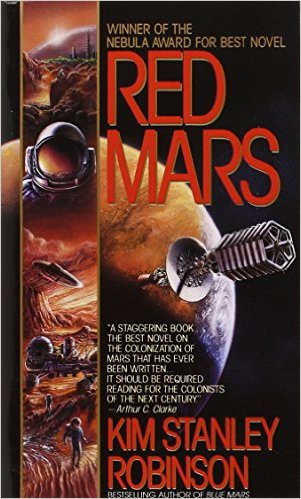
Greetings! I’ve decided to take a break from posting fiction-in-progress, and reminisce about some of our recent adventures in Portugal and Spain. For those of you who don’t know, I recently tied the knot with my amazing wife Abi Nighthill. Months earlier we planned a honeymoon to the Iberian Peninsula. We chose Portugal to fly in and out of, because it was inexpensive, and were told by multiple people that it’s a very underappreciated vacation spot. We were both really curious about Spain as well, so we sandwiched it in.
The trip lasted around 10 days, and consisted of three major portions.
- Lisbon (Lisboa) – Lovely capitol of Portugal.
- Bilbao (Bilbo) – The largest city in the Basque Country of Spain.
- Porto (Oporto) – Portugal’s second largest city, home of Port wine.
We flew in and out of Madrid, and then connected to Portugal
I’m hoping to write a few posts about each leg of our journey, and cover the highlights. My purpose here is more to recount our experiences, and not necessarily to make recommendations or paint an accurate picture of what these places are like. We tried to go off the beaten path whenever possible, and we skipped some of the usual “must-see” attractions in each place.
To start with, here are some cool things we did in and around Lisbon.
Lisboan Fado

The traditional music of Portugal is called fado. It contains the “soul of the Portuguese,” embodied in the Portuguese word “saudade.” There is no direct English translation of this word, but basically it means “longing,” or the feeling that follows after one has experienced great loss. It is definitely very sad, but quite beautiful music. Traditionally it is performed with a vocalist (male or female), and two musicians on classical and Portuguese guitar.
Abi and I went to two different fado shows in Lisbon. Our first night there (after sleeping the better part of a day), we went to a hip sort of bar that attracted a younger crowd. The interior was loaded with local artwork, and even our place mats were creatively styled. Our singer for the evening was male, and his performance seemed to be geared toward easing tourists into what can be, for some, a challenging style of music. He was actually pretty funny, and didn’t fit my image of what a fado singer was. Still, it was a great introduction to the culture, and the excellent wine and Portuguese tapas didn’t hurt either.

Our second fado show was a little more traditional. The space was small, dark and intimate. We were right up front for the performance, and this time we had a female singer (a fadista). She had the shawl, the saudade vibe, and really belted those sorrowful tunes.
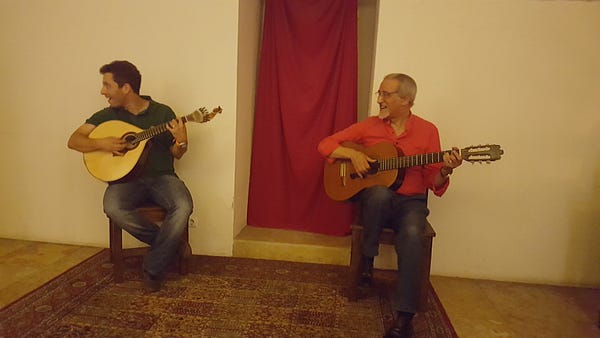
Sintra (Quinta da Regaleira)
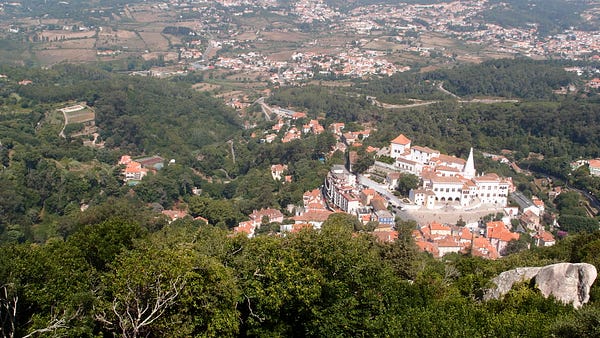
At one point we took a day trip out to a neighboring town, Sintra, which is a popular spot for locals and tourists alike. The trip was easy enough, since there’s a commuter rail line that connects with the city. Sintra is located west of Lisbon, in a range of hills not far from the coast. It was a popular place for the royal family of Portugal to spend their leisure time, as well as an assortment of aristocrats, rich capitalists, and so on.
There’s a lot to see in this seemingly small town. The royal family had two summer palaces here, there’s a ruined castle dating back to the time of the Arabs in Portugal, and more summer homes and palaces than anyone could see in a day. We hit the Pena Palace, and the Moorish Castle, and that managed to take up much of the morning and the afternoon. These were fascinating in their own way, but in the middle of August, they were packed with both local and foreign tourists.

But the true highlight of that visit was the strange and mysterious Quinta da Regaleira. This mansion and the surrounding gardens were bought in the 19th century by an eccentric millionaire who was obsessed with the occult. He hired an Italian architect to transform his whole estate into a bizarre work of esoteric symbolism. The grounds feature twisting pathways, carved figures from mythology and different religious traditions, underground tunnels, and an “initiation well” that has a winding staircase built into it, allowing visitors to venture underground and explore secret caves.
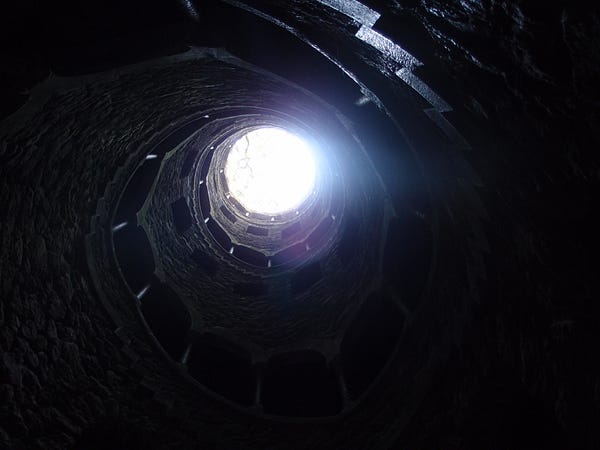
Abi and I were most excited about the well, and our journey through the grounds was built around the goal of finding it. Even with a map, we got hopelessly lost, and we ended up visiting nearly every strange place in the estate before we found it. After descending and wandering through dimly lit caves, we found another, unfinished well, that we could climb up and return to the surface. As she put it, we were “initiated,” then “uninitiated.”

We also found, inexplicably, a field full of cats.
Literary Lights of Portugal
While we were visiting Portugal (and before we left), I tried to immerse myself in the local literary tradition. I didn’t know much about Portuguese literature, and I find reading the great works can add another layer of fun onto seeing the sights. I sampled Jose Saramago, probably the best known name because of his novel Blindness. Eca de Quieros is a 19th century novelist who wrote in a realist style, and his work is both insightful and sometimes really funny. Luis de Camoes is the Shakespeare or Cervantes of Portuguese letters. He wrote an epic poem in the style of the Odyssey called the Lusiads. He also had possibly the craziest life of any writer I can think of, complete with battles, doomed love affairs, and shipwrecks.

But the writer I chose to read throughout most of the trip was Fernando Pessoa. He is associated with the Modernist tradition, and did most of his writing in the early twentieth century. He is most famous for inventing dozens of alternate writing personas, or “heteronyms” for himself. More than simple pen names, these people he wrote as had complete fictional histories and identities, and sometimes expressed very different opinions from one another. His longest work is the “Book of Disquiet,” which I am still currently reading.
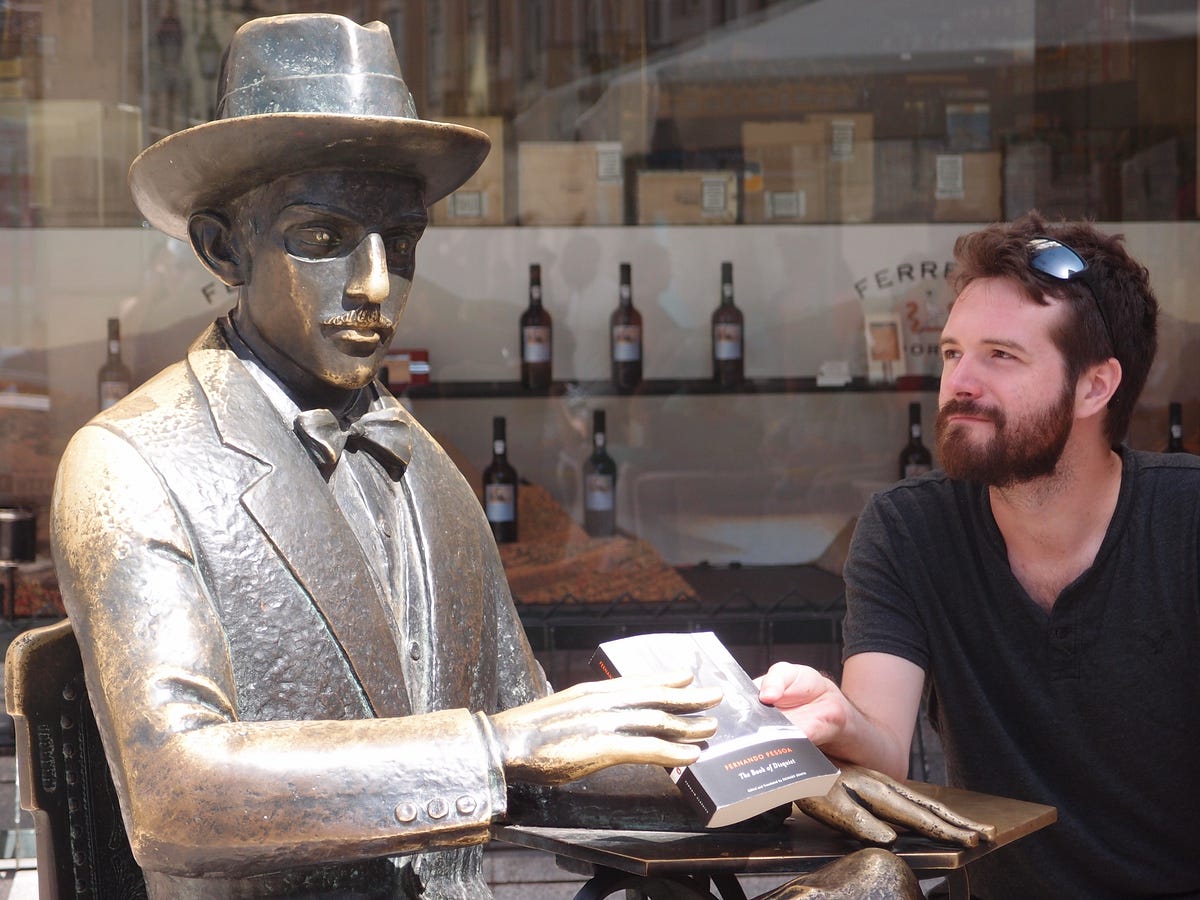
Abi and I visited the cafe that Pessoa was known to spend time at. The Cafe a Brasileira was a hot spot for artists and bohemians in the olden days. I also found out from reading signs that the word “pessoa” in Portuguese means “person,” which is kind of ironic. His name sounded like “Fernando Person,” but he was really lots of people!
Pastel de Nata

We tried some decent food in Lisbon, but my favorite culinary experience was the pastries. One kind in particular is incredibly popular all over the country, the Pastel de Nata. These are little tarts filled with sweet egg custard, baked in the oven. I must have tried these at 8 different restaurants throughout Portugal. The best ones I had were at La Brasilieira, but supposedly the best of all are located in the neighborhood of Belem, where the Pastels were invented by monks. I heard there were crazy long lines, so we avoided them. These tarts are so popular that there’s even a chain of bakery/restaurants called “I Love Nata.” I’ll have to find a place that makes them stateside…

Anyway, those are my personal highlights for Lisbon. My next post will be for Basque Country and Bilbao!




